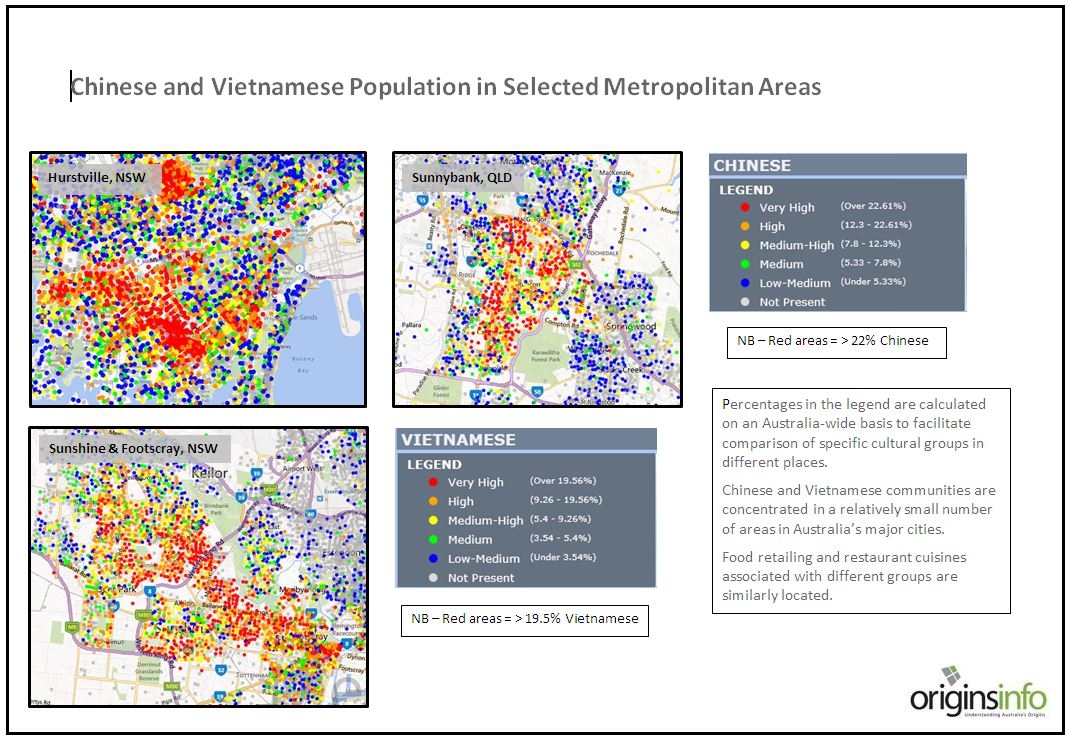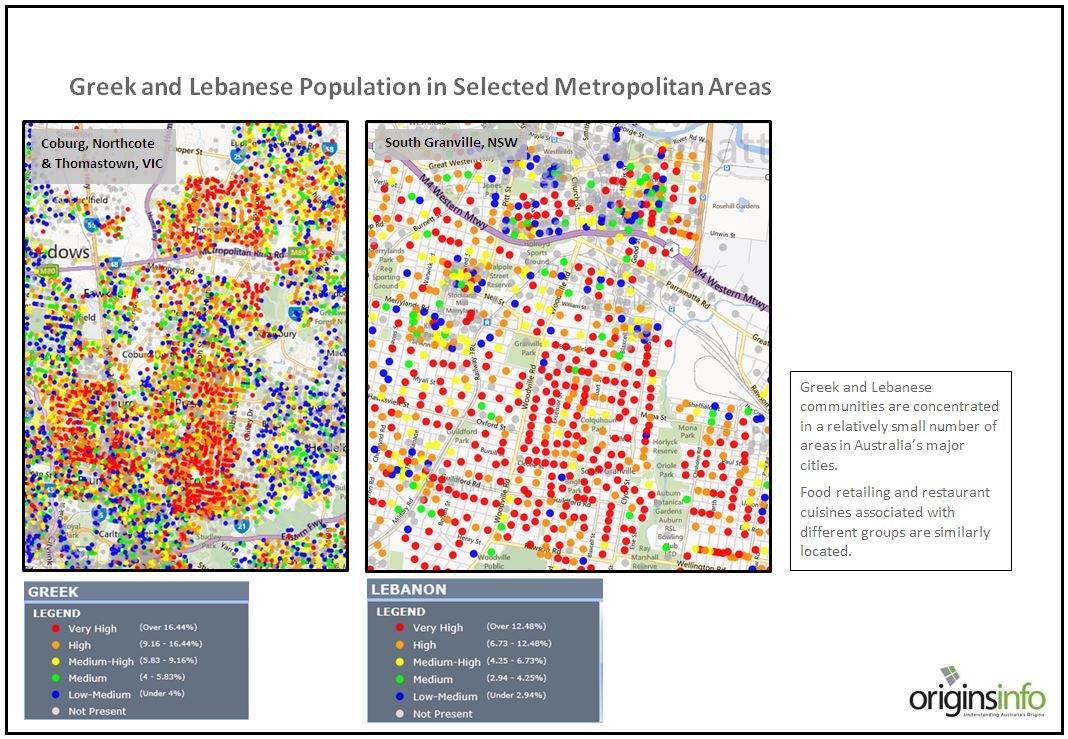Vietnamese and Lao immigrants have settled largely in the suburbs of Richmond, Footscray, St Albans and Springvale in Melbourne, and Cabramatta, Bankstown, Canley Vale and Marrickville in Sydney. In these suburbs, there is also a multitude of Vietnamese food markets, greengrocers, restaurants and convenience stores.
The Migrant Contribution to Australia’s Gastronomy
In the previous edition of the newsletter, we focused on the relationship between migrant communities and food production and processing industries in regional Australia. This time we scan our major cities to see how distinct migrant districts have emerged and how this is often reflected in a patchwork of suburban culinary specialisation.
We also spotlight the stories of three Italian families who settled in Melbourne and were pioneers in introducing new foods to a predominantly Anglo-Celtic ‘meat and two veg’ society. These are just three of many stories of migrant families who, from humble beginnings have built successful food businesses and have helped to shape Australian cuisine today.
Even before the war, there were countless Italian cafes, restaurants, delis, grocers and small food companies flourishing around inner Melbourne. One that became particularly popular was Mario’s in Exhibition Street established in the 1930s by migrants from Milan – Mario and Maria Viganò. They later purchased land in South Morang to provide fresh produce for the restaurant and today, their weekend retreat houses the Farm Viganò restaurant.
The seminal influence of the Viganò family on Melbourne’s cuisine continued through granddaughter Mietta. As a restaurateur and culinary critic she played a key role in refining and redefining haute cuisine in Australia.
Nello and Bruna Borghessi migrated to Melbourne from Tuscany in 1929 and as wartime anti-Italian sentiment subsided, Nello founded La Tosca Food Processing Company in Melbourne in 1947. After a period of producing canned vegetable products, the company found a niche in the production of fresh ravioli and other forms of pasta that endures to this day.
Australia’s first pizzeria (Toto’s) opened in Lygon Street, Carlton in 1961 by Salvatore Della Bruna and Franco Fera. Today, there are thousands of pizzerias in all cities and in many rural areas. In fact the tradition has developed so much that a Melbourne-based restaurant recently took out the top prize at the Pizza World Championship in the Italian city of Parma. Johnny Di Francesco who is the owner of 400 Gradi in Lygon Street, East Brunswick won the specialita traditionale garantita for his margherita pizza. He was up against 600 entrants from 35 countries including six from Australia.
These and other pioneering migrants paved the way for our present diversity in food opportunities and helped redefine contemporary Australian cuisine as a fusion of international styles.
Of course, it goes beyond food. Australians have access to one of the most developed and vibrant coffee cultures in the world. This stems largely from the expectations and standards established by early Greek and Italian migrants – both at home and in the plethora of small businesses established in high foot traffic central areas of our major cities.
Global coffee brands and franchises such as Starbucks and Gloria Jeans can be found, but they have not thrived in the same way as they have in other parts of the word – largely because of a pre-existing quality product and a preference for many Australians to patronise independent cafes and restaurants.
Nationally, the proportion of people with Italian, Greek, Chinese or Vietnamese ancestry employed in the food production and distribution industry indexes at 127 – meaning that these groups are over-represented in this industry compared with the rest of the population.
Many people engaged in this sector operate small businesses, which goes some way to explain why recent Origins research into ASX200 board members and senior executives shows an under-representation of people with culturally diverse backgrounds. It seems that many members of migrant communities in Australia are successful in setting up small businesses which often engage the talents of extended family members even after the completion of formal education. Perhaps along with other forces, the result is an under-representation of culturally diverse talent at the senior levels of corporate Australia.
The strong contribution of migrant communities in widening Australia’s culinary options is reflected in a ‘geography of outdoor eating’ which, in turn, is sometimes associated with demographic patterns of residential preference.
In most capital cities there are distinct food districts that often coincide with areas adopted by Australia’s immigrant populations. In each of the capital cities there is a ‘Chinatown’, usually close to the CBD, as well as satellite centres of predominantly Chinese cuisine. Chinese communities and Chinese restaurants have emerged in Little Bourke Street and Box Hill in Melbourne; in Sydney we find them in Chatswood, Hurstville, Ashfield and Marrickville, and in Brisbane, Sunnybank, Algester and Roachdale are the places to go, as shown in the following map:

There are areas of almost exclusive Italian cuisine in Carlton in Melbourne, and Haberfield and Leichhardt in Sydney. Melbourne, with the largest population of Australians with a Greek background, has a strong Greek character in Oakleigh, the Inner North, and in its historical precinct on Lonsdale Street between Russell and Swanston in the CBD.

Brunswick and Coburg in Melbourne have a strong Turkish and Lebanese influence, while in Sydney, people with a Turkish background are strongly concentrated in Auburn and Lebanese can be found in Lakemba. Melbourne has a strong Jewish community in the suburbs of Caulfield and St Kilda where many shops and restaurants offer kosher food. A similar pattern is found in the eastern suburbs of Sydney.
Indian restaurants are widely dispersed, but close co-location with community concentration occurs in Harris Park in Sydney, and Clayton and Dandenong in Melbourne.
This article and its predecessor have highlighted the close link between Australia’s culturally diverse communities and the food production industry. In rural areas this has determined the settlement patterns of many of those communities and a resultant dependence on the continued success of agricultural production and processing industries. In urban areas, the settlement patterns have spawned a ‘geography of food’ ranging through production, processing, retailing, and cafes and restaurants.